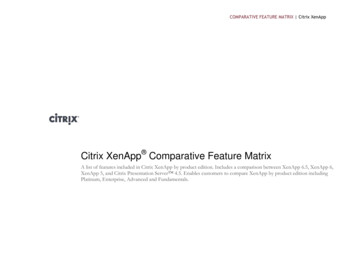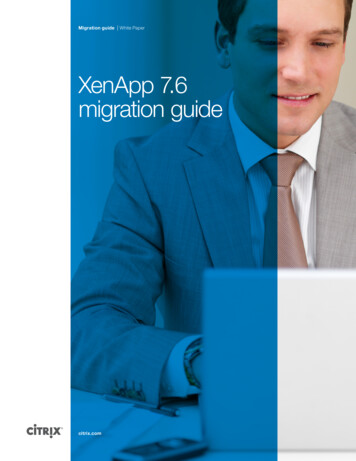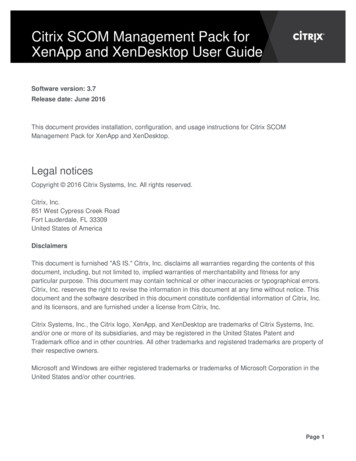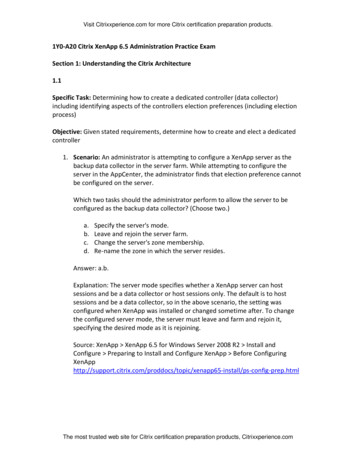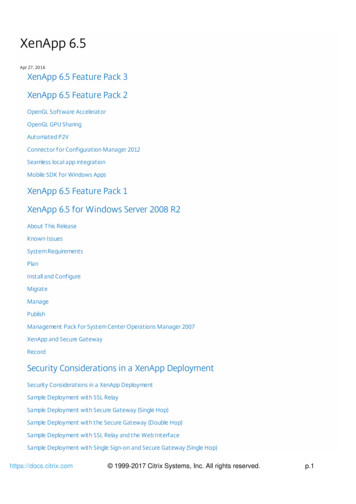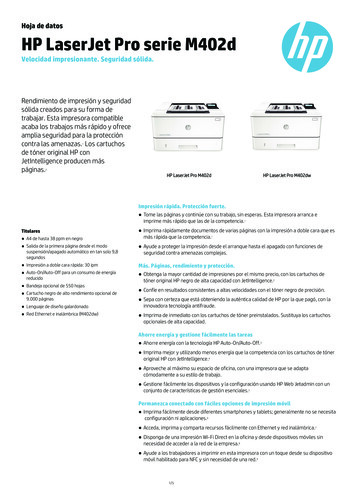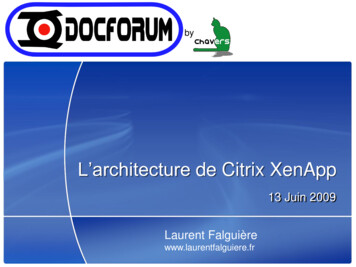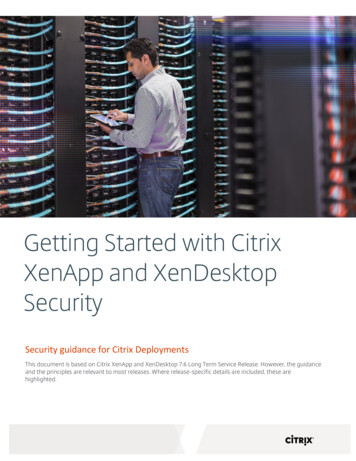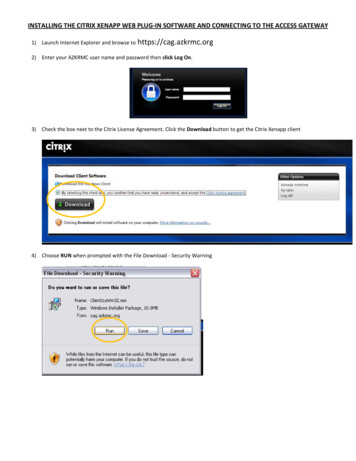
Transcription
Citrix XenApp 6.5White PaperScalability andeconomics ofXenApp onAmazon cloudcitrix.com
Citrix XenApp 6.5 White PaperContentsIntroductionAmazon Web ServicesCitrix XenApp Results summaryScalability testing in a multi-user environmentTest resultsTest Setup and configurationsAWS instance test configuration for single instance scalabilityXenApp 6.5 configuration for 1,000 user scalabilityTesting methodologyOverviewLoad generationUser workload simulation – Login VSI from Login ConsultantsTesting procedurePre-test setup for single-instance and complete farm testingSuccess criteriaTest resultsSingle-instance validationCluster Compute InstancesCluster Compute Eight Extra Large Instance – cc2.8xlargeCluster Compute Quadruple Extra Large Instance – cc1.4xlargeHigh-CPU InstancesHigh-CPU Extra Large Instance – c1.xlargeHigh-Memory InstancesHigh-Memory Quadruple Extra Large Instance – m2.4xlargeHigh-Memory Double Extra Large Instance – m2.2xlargeMulti-instance validation – 1,000 usersScalability considerations and guidelinesAWS Instance configurationAWS Storage best practicesHow to change the UserProfile directory to point to drive E:AcknowledgementsAppendix A: performance countersAppendix B: online resourcesCitrix reference documentsMicrosoft reference 233333435373738383940414141
Citrix XenApp 6.5White PaperIntroductionChief Information Officers (CIOs) are looking to thecloud as the new frontier for IT services, based onits ability to deliver cost-effective, enterprise-classvirtual desktop and application solutions as providedby Citrix XenDesktop . The attractiveness of aXenDesktop, cloud-based desktop and applicationoffering is driven by the ever-evolving demandsof workforce growth, flexibility and geographicaldisbursement. The ability to reallocate upfront costsof a large physical hardware infrastructure purchaseinto an operating expense model distributed overan extended timeframe with on-demand instantaccess to resources is an extremely attractiveproposition. The instant availability of cloud-basedresources dramatically reduces the implementationtime previously allocated for procuring, racking andcabling physical servers. The scalability and flexibilityof addressing a dynamic shift in workforce, albeitthrough a merger, acquisition or simple seasonaldemand, provides even more business justificationfor a cloud-oriented deployment. Most importantly,by delivering virtual desktops and applicationsthrough XenDesktop utilizing Amazon Web Services,CIOs are able to deliver a powerful virtualizationsolution with a price point as low as one penny anhour per user.citrix.com3
Citrix XenApp 6.5White PaperAmazon Web ServicesSince early 2006, Amazon Web Services (AWS) has provided companies of allsizes with an infrastructure web services platform in the cloud. With AWS you canrequisition compute power, storage, and other services–gaining access to a suiteof elastic IT infrastructure services as your business demands them. You pay onlyfor what you use, with no up-front expenses or long-term commitments, makingAWS the most cost-effective way to deliver your application to your customers andclients. With AWS, you can take advantage of Amazon.com’s global computinginfrastructure, which is the backbone of Amazon.com’s multi-billion-dollar retailbusiness and transactional enterprise who’s scalable, reliable, and securedistributed computing infrastructure has been honed for over a decade.AWS is cost effective, dependable, flexible and comprehensive. With AWS, youpay only for what you use, with no up-front expenses or long-term commitments.The Amazon cloud is scalable, with massive compute capacity and storage. It isreliable, redundant and secure.Amazon Virtual Private Cloud (VPC) lets you provision a private, isolated section ofthe AWS cloud where you can launch AWS resources in a virtual network that youdefine. With Amazon VPC, you can define a virtual network topology that closelyresembles a traditional network that you might operate in your own datacenter.You have complete control over your virtual networking environment, includingselection of your own IP address range, creation of subnets, and configuration ofroute tables and network gateways.You can easily customize the network configuration for your Amazon VPC. Forexample, you can create a public-facing subnet for your webservers that hasaccess to the Internet and place your backend systems, such as databases orapplication servers, in a private-facing subnet with no Internet access. You canleverage multiple layers of security, including security groups and network-accesscontrol lists, to help manage access to Amazon EC2 instances in each subnet.Citrix XenApp Citrix XenApp 6.5 provides advanced management and scalability, a richmultimedia experience over any network, and self-service applications withuniversal device support ranging from laptops to smartphones. Full support forWindows Server 2008 R2 and seamless integration with Microsoft App-V,XenApp 6.5 provides session and application virtualization technologies that makeit easy for customers to centrally manage applications using any combination oflocal and hosted delivery to best fit their unique requirements.XenApp 6.5 introduces significant enhancements that simplify applicationmanagement and bring unprecedented levels of scalability to increase costsavings and datacenter efficiency. XenApp gives you the ability to centrallymanage heterogeneous applications and deliver Software as a Service (SaaS) toany workforce.citrix.com4
Citrix XenApp 6.5White PaperDelivering these desktops and applications from XenApp presents uniquechallenges to administrators who are accustomed to delivering traditional cloudhosted applications or services. Being able to determine how many users canbe hosted on a single Amazon Elastic Compute Cloud (Amazon EC2) instance iscritical in order to achieve maximum operation efficiency.This whitepaper examines the scalability of XenApp 6.5 on various EC2 instances.It will guide you through the selection and sizing of the different Amazon EC2instance types, as well as the economic impact of using these instances, allowingyou to further reduce cost while securely delivering applications to anyone,anywhere, anytime, on any device.Results summaryIn order to determine user scalability of XenApp servers, the Login VSIperformance and scalability testing tool from Login Consultant was used tosimulate real-world user interactions within Microsoft Office Professional 2010applications. Login VSI allows for complete test automation including sessionlaunch, user action simulation and the monitoring of session performancecharacteristics.The bar graph below shows the maximum number of simulated XenApp usersessions that each EC2 instance configuration can support before encounteringa user-experience bottleneck. Please see the detailed results section for moreinformation on the bottlenecks.Figure 1 XenApp Hosted Shared Desktops per AWS Instance Typecitrix.com5
Citrix XenApp 6.5White Paper6Table 1 AWS Compute costing per hourInstance typeComputeRAMunits(GB)Standard small11.7Standard medium2Standard large4Standard extra largevCPUsEast CoastUserCost per hrCost per hrSessionsper user1 0.1150N/A3.72 0.2305 0.04607.52 0.4609 0.05118154 0.92018 0.0511Micro 32-bit or 64-bit10.6131 0.0300N/AHigh-memory extra large6.517.12 0.57017 0.0335High-memory double1334.24 1.14033 0.03452668.48 2.28065 0.0351High-CPU medium51.72 0.2852 0.1425High-CPU extra large2078 1.14023 0.0495Cluster compute33.52316 1.61085 0.01898860.532 2.970150 0.019833.52216 2.60085 0.0306extra largeHigh-memory quadrupleextra largequadruple extra largeCluster compute eightextra largeCluster GPU quadrupleextra largeFor reference, two types of XenApp AWS sample environments are provided for anestimate of the costs of running a XenApp 6.5 farm on AWS.These sample reference designs are for a 1,000 CCU and 10,000 CCU XenAppFarm, respectively.Both designs use a core infrastructure that is powered on 24 hours a day, and adynamic, elastic part that is active for 14 hours a day, covering normal eight hourwork days, as well as providing ample margin for work shifting.The design makes use of a three year term of AWS Reserved Instances insteadof on-demand instances. With Amazon EC2 Reserved Instances, you pay a low,one-time fee and in turn receive a significant discount on the hourly charge for thatinstance. See http://aws.amazon.com/ec2/reserved-instances/ on the AmazonWeb Services site for more details.The XenApp server instances have been configured with Amazon Elastic BlockStore (EBS) storage for their boot device and with local-instance storage to holdvolatile data such as pagefiles and user profiles. EBS storage provides block-levelstorage volumes for use with Amazon EC2 instances. Amazon EBS volumesare off-instance storage that persist independently from the life of an instance.Amazon EBS provides high availability, highly reliable storage volumes, placed andautomatically replicated in a specific Amazon Availability Zone.citrix.com
Citrix XenApp 6.5White PaperAvailability Zones are distinct locations that are engineered to be insulatedfrom failures in other Availability Zones and provide inexpensive, low latencynetwork connectivity to other Availability Zones in the same Region. By launchinginstances in separate Availability Zones, you can protect your applications fromfailure of a single location. Regions consist of one or more Availability Zones, aregeographically dispersed, and will be in separate geographic areas or countries.With Amazon EBS, volume storage is charged by the amount of storage allocated,and is priced at a rate of 0.10 per allocated GB per month. Amazon EBS,however, also charges 0.10 per 1 million I/O requests to a volume.Given that each XenApp session generates on average 7-8 IOPS per user, it isadvised that you use local- instance storage instead of EBS for any volatile data.Local-instance storage is an inexpensive way to provide high-speed storage andonly persists during the life of the instance.Figure 2 XenApp Farm on AWS for 1,000 hosted shared desktopscitrix.com7
Citrix XenApp 6.5White PaperTable 1 XenApp on AWS 1,000 desktops costing informationArchitecture up to 1,000 usersThis sample design makes use of a combination of two Citrix Secure Gatewayand Citrix Web Interface instances to provide access, one per AWS availabilityzone. It uses one dedicated zone data collector and XML broker, one per AmazonAvailability Zone, as well as two core XenApp Server instances available 24 hoursin session-only mode.The above shown spreadsheet has been made available as a tool to assist youin calculating your own estimated costs for running you XenApp farm on AmazonWeb Services.It can be downloaded from the Citrix Developer Network community page forAmazon Web Services. trix.com8
Citrix XenApp 6.5White PaperFigure 3 XenApp Farm on AWS for 10,000 hosted shared desktopscitrix.com9
Citrix XenApp 6.5White PaperTable 2 XenApp on AWS 10,000 desktops costing informationArchitecture up to 10,000 usersThis sample design makes use of a combination of Citrix NetScaler and CitrixAccess Gateway Enterprise VPX and Cloud Gateway Express instances toprovide access, two per Amazon Availability Zone. It uses two dedicated zonedata collectors and XML brokers, one per Amazon Availability Zone, as well as fourcore XenApp server instances available 24 hours in session-only mode. An SQLDB Server is set up in redundant mode using SQL Mirroring.Database mirroring can be used to maintain a single standby database, or mirrordatabase, for a corresponding production database that is referred to as theprincipal database. Database mirroring runs with either synchronous operation inhigh-safety mode, or asynchronous operation in high-performance mode. In highsafety mode with automatic failover, which is recommended for XenApp, a thirdserver instance, known as a witness, is required. This enables the mirror serverto act as a hot standby server. Failover from the principal database to the mirrordatabase happens automatically and typically takes several seconds.citrix.com10
Citrix XenApp 6.5White PaperScalability testing in a multi-user environmentSeveral important factors need to be taken into consideration when determiningthe number of users an instance can support. Sizing a XenApp server Instancedepends on the following criteria: Specifications of the instance type, such as CPU, memory, disk and networkcapacity Applications, their requirements and how they interact with the system Degree of user activityBefore any tests are executed, instance resource limits and response timethresholds need to be set in order to determine the number of users a particularinstance can support, for example: Eighty percent CPU usage Seventy percent memory usage, up to the point where paging begins to saturatethe disk Acceptable user response times ( 4000ms)These limits should be set to accommodate utilization peaks and future growth;optimal user density of an instance does not equate to its maximum capacity.If you size a server based solely on its maximum capacity, you can expectproblems, such as instance instability and poor user response times. Thus, in eachperformance test, consider the relationship between instance performance andthe user experience.For example, high CPU utilization can be the result of a low memory conditionwhere the system is swapping applications from memory to disk, causing a largenumber of disk interrupts. Without collecting data for all of the machine’s majorsubsystems, we would easily conclude that the bottleneck was the CPU, when itwas a memory bottleneck all along.Please reference the chart in Appendix A for performance counters for all of themajor subsystems (CPU, memory, disk and network) that should be monitored inthese types of scalability tests.Test resultsThe following section gives a detailed performance analysis for the tests usedto determine the scalability impact of virtual processors (vCPU) and the impactof multiple virtual machines executing concurrently on the same physical server.The Login VSI performance tool used to conduct the scalability tests provides amechanism to automatically collect user experience information (VSIIndex avg).In order to determine the number of users a configuration can support, this userexperience data is overlaid with the performance data of the subsystem thatexperienced a performance bottleneck. The point where user experience andthe subsystem bottleneck intersect determines the number of users that theconfiguration can support. For convenience, a chart with all of the subsystem datais displayed for each test.citrix.com11
Citrix XenApp 6.5White PaperThe guidelines presented in this section should be used as a reference, and areonly valid if your workloads and applications are similar to those executed in ourtests. As always, we recommend executing your own scalability tests, utilizing yourserver and applications when making your final sizing decisions.Test Setup and configurationsIn this project, we tested the different available Amazon EC2 instances as singleinstances and we also tested them as part of a XenApp 6.5 Farm hosting 1,000users to illustrate the linear scalability.AWS instance test configuration for single instance scalabilityAWS Instances 1 x domain controller also functioning as DNS server 1 x dedicated XenApp DC/XML Broker 1 x Web Interface 1 x VSI controller 5 x VSI launchers AWS Security Groups Private security group Public security group XenApp Instances are configured with a single EBS boot volume and 1-2 localinstance storage volumes, depending on the instance type. The local instancevolumes are configured to hold volatile data such as the pagefile and user profilescitrix.com12
Citrix XenApp 6.5White PaperSoftware components Standard Windows 2008 R2 AMIs 64-bit XenApp 6.5 with latest public Hotfixes Web Interface 5.4 Citrix Receiver 3.1 Office 2010 LoginVSI 3.5XenApp 6.5 configuration for 1,000 user scalabilitycitrix.com13
Citrix XenApp 6.5White PaperAWS Components 1 x domain controller, also functioning as DNS server 1 x dedicated XenApp DC/XML Broker 1 x Web Interface 16 x VSI launchers AWS Security Groups Private security group Public security group EBS Volumes for XenApp server instances 1 x 30GB EBS boot volume 5 x 10GB EBS volumes configured as a single striping setXenApp servers can generate very high amounts of IOPS. It is therefore advisedto spread the disk I/O over multiple EBS volumes. This is to ensure that theconfigured storage for the XenApp server instances can provide the requiredamount of IOPS. Amazon EBS is namely a shared infrastructure. Using multipleEBS volumes will reduce the impact of other customer workloads.Software components Standard Windows 2008R2 AMIs 64-bit XenApp 6.5 with latest public Hotfixes Web Interface 5.4 Citrix Receiver 3.1 Office 2010 LoginVSI 3.5citrix.com14
Citrix XenApp 6.5White PaperTesting methodologyOverviewThe objective of the test was to demonstrate XenApp 6.5 scaling capabilities andto understand the Amazon EC2 and EBS utilization.Through conducting the same series of single-server scalability tests against thedifferent instance types, we were able to run consistent and comparable tests.Load generationWithin each test environment, load generators were utilized to put demand onthe system to simulate multiple users accessing the XenApp 6.5 environment andexecuting a typical end-user workflow. To generate load within the environment, anauxiliary software application was required to generate the end-user connectionto the XenApp environment; to provide unique user credentials, to initiate theworkload; and to evaluate the end user experience.In the hosted shared desktop test environment, sessions launchers were used tosimulate multiple users making a direct connection to XenApp 6.5 via a Citrix HDXprotocol connection.User workload simulation – Login VSI from Login ConsultantsOne of the most critical factors of validating a XenApp deployment is identifying areal-world user workload that is easy for customers to replicate and standardizeacross platforms in order to allow customers to realistically test the impact of avariety of worker tasks. To accurately represent a real-world user workload, athird-party tool from Login Consultants was used throughout the Hosted SharedDesktop testing.The tool has the benefit of taking measurements of the in-session response time,which provides an objective way to measure the expected user experience for anindividual desktop throughout large-scale testing, including login storms.The Virtual Session Indexer, Login Consultants’ Login VSI 3.5 methodology, designedfor benchmarking Server Based Computing (SBC) and Virtual Desktop Infrastructure(VDI) environments is completely platform and protocol independent and hence allowscustomers to easily replicate the testing results in their environment.Login VSI calculates an index based on the amount of simultaneous sessions thatcan be run on a single machine.Login VSI simulates a medium workload user, also known as a knowledge worker,running generic applications such as: Microsoft Office 2007 or 2010, InternetExplorer 8 including a Flash video applet and Adobe Acrobat Reader. Note: For thepurposes of this test, applications were installed locally, not streamed or hosted onother XenApp servers.Like real users, the scripted Login VSI session will leave multiple applications openat the same time. The medium workload is the default workload in Login VSI andwas used for this testing. This emulated a knowledge worker using Office, IE,printing and PDF.citrix.com15
Citrix XenApp 6.5White Paper Once a session has been started, the medium workload will repeat every 12minutes During each loop, the response time is measured every two minutes The medium workload opens up to five apps simultaneously The type rate is 160ms for each character Approximately two minutes of idle time is included to simulate real-world usersEach loop will open and use: Outlook 2007/2010: browse 10 messages Internet Explorer: one instance is left open (BBC.co.uk); one instance is browsed toWired.com, Lonelyplanet.com and heavy 480p Flash application gettheglass.com Word 2007/2010: one instance to measure response time; one instance toreview and edit document Bullzip PDF Printer and Acrobat Reader: the word document is printed andreviewed to PDF Excel 2007/2010: a very large randomized sheet is opened PowerPoint 2007/2010: a presentation is reviewed and edited 7-zip: using the command-line version, the output of the session is zippedA graphical representation of the medium workload is shown in Figure 55.citrix.com16
Citrix XenApp 6.5White PaperFigure 4 Graphical representation of medium workloadYou can obtain additional information on Login VSI from http://www.loginvsi.com.Testing procedureThe following protocol was used for each test cycle in this study to ensureconsistent results.Pre-test setup for single-instance and complete farm testingAll instances under this test were shut down utilizing the AWS Console. Alllaunchers for the test were shut down. They were then restarted until the requirednumber of launchers were running with the Login VSI Agent at a “waiting for test tostart” state.Success criteriaThere were multiple metrics that were captured during each test run, but thesuccess criteria for considering a single test run as pass or fail was based on thekey metric, VSI Max. The Login VSI Max evaluates the user response time duringan increased user load and assesses the successful start-to-finish execution of allthe initiated virtual desktop sessions.citrix.com17
Citrix XenApp 6.5White PaperLogin VSI MaxVSI Max represents the maximum number of users the environment can handlebefore serious performance degradation occurs. VSI Max is calculated based onthe response times of individual users as indicated during the workload execution.The user response time has a threshold of 4000ms and all users’ response timesare expected to be less than 4000ms in order to assume that the user interactionwith the virtual desktop is at a functional level. VSI Max is reached when theresponse times reach or exceed 4000ms for six consecutive occurrences.If VSI Max is reached, that indicates the point at which the user experience hassignificantly degraded. The response time is generally an indicator of the host CPUresources, but this specific method of analyzing the user experience provides anobjective method of comparison that can be aligned to host CPU performance.Note: In the prior version of Login VSI, the threshold for response time was2000ms. The workloads and the analysis have been upgraded in Login VSI 3to make the testing more aligned to real-world use. In the medium workload inLogin VSI 3.0, a CPU-intensive 480p flash movie is incorporated in each test loop.In general, the redesigned workload would result in an approximate 20 percentdecrease in the number of users passing the test, versus Login VSI 2.0 on thesame server and storage hardware.Calculating VSI MaxTypically, when a simulated Login VSI user is logged on, the desktop workloadis scripted in a 12 -14 minute loop. After the loop is finished, it will restartautomatically. Within each loop, the response time of seven specific operations ismeasured in a regular interval: six times within each loop.The seven operations from which the response times are measured are: Copy new document from the document pool in the home drive This operation will refresh a new document to be used for measuring theresponse time. This activity is mostly a file-system operation Starting Microsoft Word with a document This operation will measure the responsiveness of the operating system (OS)and the file system. Microsoft Word is started and loaded into memory; alsothe new document is automatically loaded into Microsoft Word. When thedisk I/O is extensive or even saturated, this will impact the File Open dialogueconsiderably Starting the File Open dialogue A small part of this operation is handled by Word and a large part by theoperating system. The File-Open dialogue uses generic subsystems andinterface components of the OS. The OS provides the contents of this dialogue Starting Notepad This operation is handled by the OS (loading and initiating Notepad.exe) andby the Notepad.exe itself through execution. This operation seems instant froman end-user’s point of viewcitrix.com18
Citrix XenApp 6.5White Paper Starting the Print dialogue A large part of this operation is handled by the OS subsystems, as the Printdialogue is provided by the OS. This dialogue loads the print subsystem andthe drivers of the selected printer. As a result, this dialogue is also dependenton disk performance Starting the Search and Replace dialogue This operation is handled within the application completely; the presentation ofthe dialogue is almost instant. Serious bottlenecks on the application level willimpact the speed of this dialogue Compress the document into a zip file with 7-zip command line This operation is handled by the command-line version of 7-zip. Thecompression will very briefly spike CPU and disk I/OThese measured operations with Login VSI do hit considerably differentsubsystems, such as CPU (user and kernel), memory, disk, the OS in general, theapplication itself, print, GDI, etc. These operations are specifically short by nature.When such operations are consistently long, the system is saturated becauseof excessive queuing on any kind of resource. As a result, the average responsetimes will then escalate. This effect is clearly visible to end-users. When suchoperations consistently consume multiple seconds, the user will regard the systemas slow and unresponsive.VSI Max ClassicVSI Max Classic is based on the previous versions of Login VSI, and is achievedwhen the average Login VSI response time is higher than a fixed threshold of4000ms. This method proves to be reliable when no anti-virus or applicationvirtualization is used.To calculate the response times, the seven activities listed in the previous sectionare totaled. To balance these measurements, they are weighted before they aresummed. Without weighting individual response times before they are totaled, onespecific measurement (out of seven) could dominate the results.Within VSI Max Classic, two measurements are weighted before they are added tothe total VSI Max response time:1. ‘Starting Microsoft Word with a document is divided by two (50%)2. ‘Starting the Search-and-Replace dialogue is multiplied by five (500%)A sample of the VSI Max Classic response time calculation is displayed in Table 16.citrix.com19
Citrix XenApp 6.5White PaperTable 3 VSI Max Classic response time calculationThen the average VSI Max response time is calculated, based on the amountof active Login VSI users logged on to the system. When the average VSI Maxresponse times are consistently higher than the default threshold of 4000ms, VSIMax is achieved.In practice, however; tests have shown a substantial increase of applicationresponse time when antivirus and/or application virtualization is used. The baselineresponse time is typically around 1400–1800ms without application virtualization orantivirus. However, when anti-virus or application virtualization is used, the baselineresponse time varies between 2500–3500ms.When the baseline response time is already so high, the VSI Max threshold of 4000msis too easily reached. VSI Max Classic will report having reached a maximum, longbefore system resources like CPU, memory or disk are actually saturated.It was therefore decided to further optimize VSI Max calculation. As of Login VSI3.0 and later, VSI Max Dynamic is introduced, to be able to support wildly varyingbaseline response times when anti-virus and/or application virtualization is used.VSI Max Classic was not used in this study.VSI Max DynamicSimilar to VSI Max Classic, VSI Max Dynamic is calculated when the responsetimes are consistently above a certain threshold. However, this threshold is nowdynamically calculated on the baseline response time of the test.Five individual measurements are weighted to better support this approach: Copy new doc from the document pool in the home drive: 100% Microsoft Word with a document: 33.3% Starting the File Open dialogue: 100% Starting Notepad: 300% Starting the Print dialogue: 200% Starting the Search and Replace dialogue: 400% Compress the document into a zip file with 7-zip command line: 200%A sample of the VSI Max Dynamic response time calculation is displayed in Table 17.citrix.com20
Citrix XenApp 6.5White PaperTable 4 VSI Max Dynamic Response Time calculationThen the average VSI Max response time is calculated, based on the amount of activeLogin VSI users logged on to the system. For this, the average VSI Max responsetimes need to be consistently higher than a dynamically calculated threshold.To determine this dynamic threshold, first the average baseline response time iscalculated. This is done by averaging the baseline response time of the first 15Login VSI users on the system.The formula for the dynamic threshold is: Average Baseline Response Time x125% 3000. As a result, when the baseline response time is 1800, the VSI Maxthreshold will now be 1800 x 125% 3000 5250ms.The baseline response time can wildly vary per vendor and streaming strategy,especially when application virtualization is used. Therefore, it is recommendedthat you use VSI Max Dynamic when comparisons are made with applicationvirtualization or anti-virus agents. The resulting VSI Max Dynamic scores arealigned again with saturation on a CPU, memory or disk level and also when thebaseline response times are relatively high.Determining VS
Store (EBS) storage for their boot device and with local-instance storage to hold volatile data such as pagefiles and user profiles. EBS storage provides block-level storage volumes for use with Amazon EC2 instances. Amazon EBS volumes are off-instance storage that persist independently from the life of an instance.
